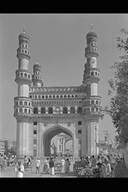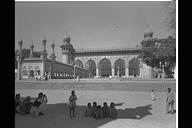
→Detailed Explanation
→The list of photos
HYDERABAD
In 1589, the 5th ruler of the Qutb Shah
Dynasty, Muhammad Quli Qutb Shah constructed a new capital,
moving the capital from Golconda to Hyderabad, From that time it
maintained prosperity as the centre of the Qutb Shah Dynasty
until the late 17th century. After the Mugalid emperor Aurangzeb
conquered Golconda in 1687, Mecca Masjid were repaired and the
city wall was built. After the 18th century it lived on as the
stronghold of Deccan control of the Nizam family that was
established by Asaf Jah .
The town is constructed on the south shore of the Musi river. The
city walls form an inverted triangle. Their construction was
begun by the last Mugalid ruler Mubaliz Khan and completed by
Nizam ul-Mulk. Buildings dating back to the Qutb Shah period
include Chahar Minar at the crossing of the centre of Hyderabad,
Jama Masjid at its north-east built in 1597, a hospital(Dar al-Shifa)is situated to the
northeast of Jama Masjid and Mecca Masjid, whose construction
started in 1614 and was completed by the Mugalid emperor
Aurangzeb, located to the south-east of Chahar Minar. In the Qutb
Shah period, there were no city walls in Hyderabad. A bridge
called Purana Pula was built where a road from Golconda in the
west area meets the Musi river, and if one follows the road to
the east, one can reach Chahar Minar. The northwest area of
Chahar Minar became a palace complex where many palace buildings
and gardens could be seen, but currently there is no trace of
them. (Naoko Fukami)
1.CHAHAR MINAR (1590/1)
2.MECCA MASJID (1617)
 |
This building is
situated at the crossing of a main road running from the
north to the south in the old city of Hyderabad. It is a
building representing the Qutb Shahi period. Especially
after the French tourist Thevenot visited Hyderabad and
appreciated its excellency, it came to be widely known in
the West. As evidenced in the fact that this building is
still used in a design of notes and stamps, it is one of
the most famous buildings representing the historical
remains of not only Hyderabad and Deccan region but the
whole India. (Matsuo Ara) →Detailed Explanation →The list of photos |
| ▲View from the south | |
 |
This is a mosque
built at the central part of the old walled city, which
is constructed at the south of the Musi river. Its
construction is said to have begun in 1617 under the
reign of Muhammad Qutb Shah of the Qutb Shahi Dynasty and
it is recognized as one of the buildings that represent
the period. However, it seems that it took long time to
finish the construction and it is said to have been
finally completed in the late 17th century. As for the
name "Mecca", there is a theory that Sultan
Muhammad let them use clay from Mecca, and that it was
compared to the Holy Kaba where pilgrims never cease to
come. (Matsuo Ara) →Detailed Explanation →Plan and The list of photos |
| ▲Overall View of the prayer room | |